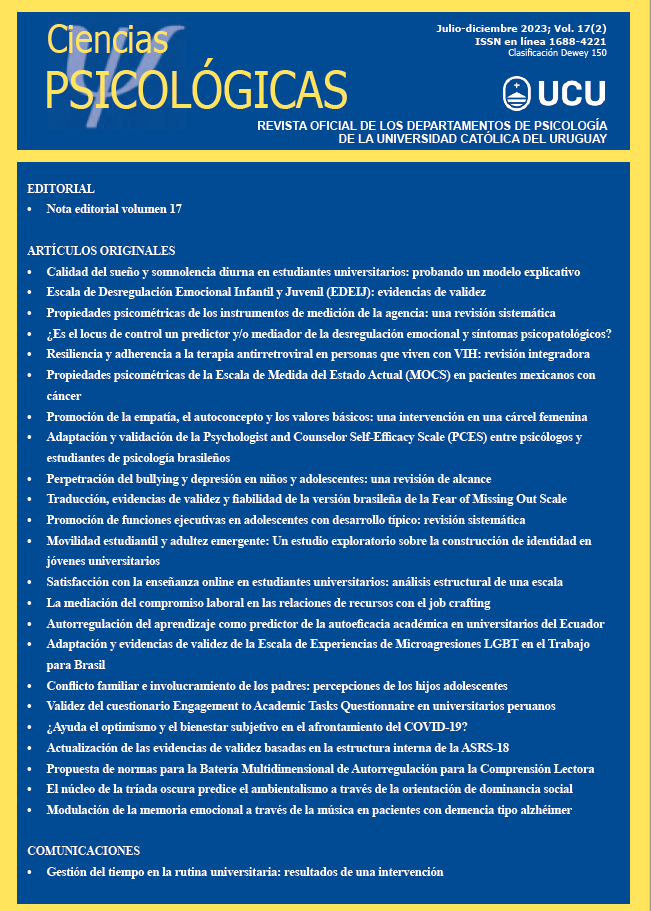Proposal of standards for Reading Comprehension Multidimensional Battery
DOI:
https://doi.org/10.22235/cp.v17i2.2852Keywords:
self-regulated learning, reading comprehension, motivation, fundamental education, psychoeducational assessmentAbstract
The main aim of this research was to establish preliminary standards for the Self-Regulation for Reading Comprehension Multidimensional Battery (BAMA-Reading), consisting of nine scales. The study sample comprised 910 Middle School students from Brazilian public schools. Norms for the BAMA-Reading scales, which have a Likert-type response format, were established based on percentiles, with the sample classified into four subgroups divided by gender, repetition history, and school year. For the EAC-CL (Educational Assessment Battery for Reading Comprehension and Learning), whose response format differs from the other scales in the battery, separate standards were established. It was found that not all scales in the battery demonstrated measurement invariance for gender, repetition history, and school year. Variances were identified in the EAC-CL concerning these variables. The results suggest caution when applying group comparison analyses in BAMA-Reading. Future studies on the battery should involve new samples and employ advanced statistical techniques to establish more definitive standards.
Downloads
References
American Educational Research Association, American Psychological Association, & National Council on Measurement in Education. (2014). Standards for educational and psychological testing. American Educational Research Association.
Boruchovitch, E. (2001). Algumas estratégias de compreensão em leitura de alunos do ensino fundamental. Psicologia Escolar e Educacional, 5(1), 19-25. https://doi.org/10.1590/s1413-85572001000100003
Brown, T. (2015). Confirmatory Factor Analysis for Applied Research (2nd Ed). Guilford Press.
Cheung, G. W., & Lau, R. S. (2012). A direct comparison approach for testing measurement invariance. Organizational Research Methods, 15(2), 167-198. https://doi.org/10.1177/1094428110391673
Cheung, G. W., & Rensvold, R. B. (2002). Evaluating Goodness-of-Fit Indexes for Testing Measurement Invariance. Structural Equation Modeling: A Multidisciplinary Journal, 9(2), 233–255. https://doi.org/10.1207/S15328007SEM0902_5
Ciascai, L., & Haiduc, L. (2011). Metacognitive strategies that Romanian pupils use when reading science textbooks. International Conference on Social Science and Humanity, 5(2), 389-392.
Damásio, B. F., & Dutra, D. F. (2017). Análise fatorial exploratória: Um tutorial com o software Factor. In B. F. Damásio & J. C. Borsa (Orgs.), Manual de desenvolvimento de instrumentos psicológicos (pp. 241-266). Vetor.
Ferraz, A. S. (2022). Autorregulação para a Compreensão de Leitura no Ensino Fundamental II: Avaliação e Intervenção [Tese de Doutorado em Psicologia]. Universidade São Francisco. https://www.usf.edu.br/publicacoes/teses.vm
Ferraz, A. S., & Santos, A. A. A. (2019). Bateria Multidimensional da Autorregulação para a Compreensão de Leitura. [Unpublished Technical Report]. Universidade São Francisco.
Ferraz, A. S., Santos, A. A. A., & Almeida, L. S. (2019). Evidence of criterion validity for the causal attribution scale. Psicologia: Teoria e Prática, 21(3), 114-134. https://doi.org/10.5935/1980-6906/psicologia.v21n3p114-134
Ferraz, S. A., Santos, A. A., Noronha, P. A., & Almeida, L. S. (2023). Psychometric properties of the Causal Attributions Scale for Reading Comprehension. Avances en Psicología Latinoamericana, 41(1), 1-22. https://doi.org/10.12804/revistas.urosario.edu.co/apl/a.112671
Field, A. (2009). Descobrindo a estatística usando o SPSS. Artmed.
Garcia, N. R., & Boruchovitch, E. (2015). As atribuições de causalidade no ensino fundamental: Relações com variáveis demográficas e escolares. Psico, 46(2), 176-187. https://doi.org/ 10.15448/1980-8623.2015.2.17642
Goss-Sampson, M. A. (2020). Statistical Analysis in JASP 0.14: A Guide for Students. https://jasp-stats.org/jasp-materials/
Graham, S. (2020). An attributional theory of motivation. Contemporary Educational Psychology, 61, 1-11. https://doi.org/10.1016/j.cedpsych.2020.101861
Kim, E. S., Cao, C., Wang, Y., & Nguyen, D. T. (2017). Measurement invariance testing with many groups: A comparison of five approaches. Structural Equation Modeling: A Multidisciplinary Journal, 24(4), 524-544. https://doi.org/10.1080/10705511.2017.1304822
Li, K. (2017). Theoretical Foundation and Previous Studies of Motivational Regulation. In K. Li (Ed.), Motivational Regulation in Foreign Language Learning (pp. 9-49). Palgrave Macmillan.
Miranda, L. C., Almeida, L. S., Boruchovitch, E., Almeida, A. R., & Abreu, S. A. (2012). Atribuições causais e nível educativo familiar na compreensão do desempenho escolar em alunos portugueses. Psico-USF, 17(1), 1-9. https://doi.org/10.1590/S1413-82712012000100002
Paiva, M. O. A., & Lourenço, A. A. (2012). A influência da aprendizagem autorregulada na mestria escolar. Estudos e Pesquisas em Psicologia, 12(2), 501-520. https://doi.org/10.12957/epp.2012.8279
Pasquali, L. (2019). Psicometria: Teoria dos testes na Psicologia e na Educação. Vozes.
Rutkowski, L., & Svetina, D. (2017). Measurement invariance in international surveys: Categorical indicators and fit measure performance. Applied Measurement in Education, 30(1), 39-51. http://dx.doi.org/10.1080/08957347.2016.1243540
Serafim, T. M., & Boruchovitch, E. (2010). A estratégia de pedir ajuda em estudantes do ensino fundamental. Psicologia: Ciência e Profissão, 30(2), 404-417. https://doi.org/10.1590/s1414-98932010000200014
Skibbe, L. E., Montroy, J. J., Bowles, R. P., & Morrison, F. J. (2019). Self-regulation and the development of literacy and language achievement from preschool through second grade. Early Childhood Research Quarterly, 46, 240-251. https://doi.org/10.1016/j.ecresq.2018.02.005
Stocker, J., & Faria, L. (2018). Concepções Pessoais de Competência e Rendimento Acadêmico: Estudo Longitudinal no Ensino Secundário Português. Psicologia: Teoria e Pesquisa, 34, 1-12. https://doi.org/10.1590/0102.3772e3433
Urdan, T., & Kaplan, A. (2020). The origins, evolution, and future directions of achievement goal theory. Contemporary Educational Psychology, 61, 101862. https://doi.org/10.1016/j.cedpsych.2020.101862
Vantieghem, W., & van Houtte, M. (2015). Are girls more resilient to gender-conformity pressure? The association between gender-conformity pressure and academic self-efficacy. Sex Roles, 73(1), 1-15. https://doi.org/10.1007/s11199-015-0509-6
Weiner, B. (2010). The development of an attribution-based theory of motivation: A history of ideas. Educational Psychologist, 45(1), 28-36. https://doi.org/10.1080/00461520903433596
White, M. C., & DiBenedetto, M. K. (2015). Self-regulation and the Common Core: Application to Ela Standars. Routledge.
Zeidner, M., & Stoeger, H. (2019). Self-Regulated Learning (SRL): A guide for the perplexed. High Ability Studies, 30(1-2), 9-51. https://doi.org/10.1080/13598139.2019.1589369
Zimmerman, B. J., & Risemberg, R. (1997). Self-Regulatory dimensions of academic learning and motivation. Handbook of Academic Learning, 105-125. https://doi.org/10.1016/b978-012554255-5/50005-3
Downloads
Published
How to Cite
Issue
Section
License
Copyright (c) 2023 Universidad Católica del Uruguay

This work is licensed under a Creative Commons Attribution 4.0 International License.
















